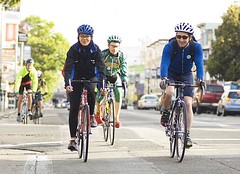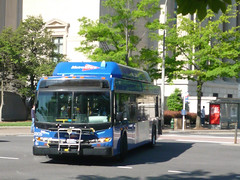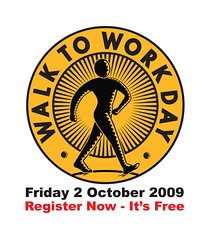Which US cities have the greenest commuting habits?

Posted October 2, 2009 at 1:58PM
Big-time kudos to Bike Pittsburgh for combing through new census data to extract and rank the commuting habits of the 60 largest US cities. The data chart on the organization's website, naturally, opens up with the ranking of bicycle commuting: Portland is number one, with a rate (six percent) astonishingly ten times the national median. But what is cool for nerds like me is that the table is interactive,  allowing us to see the rankings and numbers for several other measures important to the environment, including the rankings and percentages of commuters driving alone, those taking public transit, and those walking to work.
allowing us to see the rankings and numbers for several other measures important to the environment, including the rankings and percentages of commuters driving alone, those taking public transit, and those walking to work.
Here are the ten cities that in 2008 had the smallest portions of commuters driving alone to work, and the percentage of workers in each who did so. The national median for this statistic, sadly, is 74.2 percent, and the national average is 70.1 percent:
- New York NY 23.3
- Washington DC 37.2
- San Francisco CA 38.4
- Boston MA 41.1
- Chicago IL 50.5
- Philadelphia PA 50.7
- Pittsburgh PA 52.8
- Seattle WA 52.9
- Baltimore MD 57.9
- Oakland CA 58.1
New York (no surprise), DC and San Francisco all managed to cut their rates to half the national median or less. The worst performers among the 60 largest cities, incidentally, were Wichita and Oklahoma City.
 Here are the top ten performers displayed by the percentage of commuters who took public transit to work. The national median in the Census's American Community Survey is a sorry 4.5 percent; the average is higher at 9.0 percent (probably because the large, transit-rich population of New York City is included as a raw number). The rankings are almost identical to those for driving alone:
Here are the top ten performers displayed by the percentage of commuters who took public transit to work. The national median in the Census's American Community Survey is a sorry 4.5 percent; the average is higher at 9.0 percent (probably because the large, transit-rich population of New York City is included as a raw number). The rankings are almost identical to those for driving alone:
- New York NY 54.8
- Washington DC 35.7
- San Francisco CA 31.9
- Boston MA 31.2
- Philadelphia 26.8
- Chicago IL 26.7
- Pittsburgh PA 20.9
- Baltimore MD 19.5
- Seattle WA 17.7
- Oakland CA 17.1
The Big Apple had an impressive rate twelve times the national median;  DC's rate was eight times the national median; and San Francisco's was seven times. The worst performers? Arlington, Texas at a paltry 0.3 percent, and Oklahoma City and Tulsa at 0.8 percent.
DC's rate was eight times the national median; and San Francisco's was seven times. The worst performers? Arlington, Texas at a paltry 0.3 percent, and Oklahoma City and Tulsa at 0.8 percent.
My favorite of the tables, though, is the one for the percentage of commuters walking to work. Here the national median is 2.5 percent (I'm actually surprised that it's that high) and the average is 3.8 percent. The city rankings this time are a little different:
- Boston MA 14.3
- Washington DC 12.1
- Pittsburgh PA 11.1
- New York NY 10.3
- San Francisco CA 9.4
- Seattle WA 9.3
- Philadelphia PA 8.6
- Honolulu HI 7.9
- Minneapolis MN 6.1
- Baltimore MD 6.0
It's encouraging to see several cities near or above ten percent and, rooting for the home team, to see DC beat New York (take that, David Owen). And now that I have seen Honolulu on several lists like this, I'm going to have to stop being surprised. The worst performers were Bakersfield and Dallas.
The rankings would be even more telling, I think, if they had also included numbers for metro areas in addition to those for people living within city limits. No doubt we would have less to feel encouraged about, and there probably would be less variation top to bottom. But Bike Pittsburgh acknowledges the shortcoming, along with some other limitations. They used the data available, and it's still very interesting to confirm once again that communities that are built (relatively) compactly, with mixed uses, good transit and a decent pedestrian environment, display their merits in good transportation performance. Go here for data on all 60 cities.